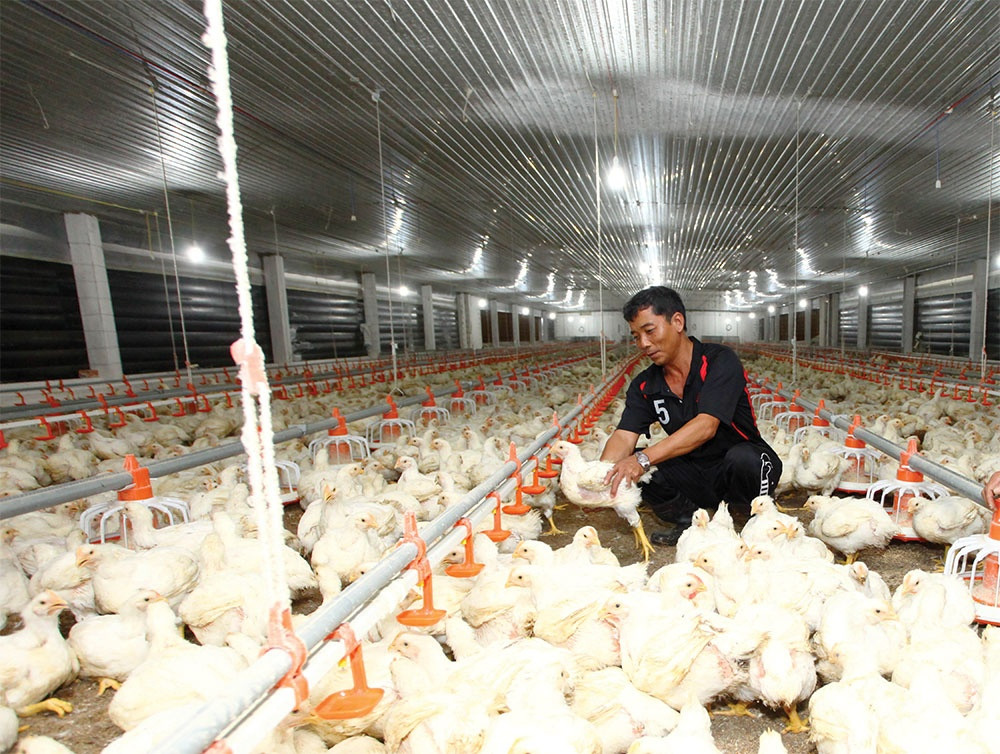 |
In the first days of the new year, many husbandry companies revealed that 2022 business results were deeply affected by losses.
“We earned no profit despite working hard the entire year. The husbandry sector has suffered from deep losses, while revenues and meagre profits in the animal feed sector cannot make up for it,” said a representative of Japfa Comfeed Vietnam.
He further explained that cheap selling prices, high costs of importing animal feed material, and African swine fever (ASF) have blown profits away. “These issues have forced most farms to scale down their size. Demand for animal feed and bioproducts dropped sharply, and capacity of sector production dipped. Meanwhile, the more breeding we carried out, the more losses were thrust upon us,” he added.
Being the leading player in the industry, business results for C.P. Vietnam in 2022 were seemingly less gloomy than others, despite its husbandry activities also making tiny profits and sharply dropping over the previous year.
“The price of pigs is maintained at too cheap an amount, around $2.15-2.60, while chickens were priced at $1.35-1.50 per kg during the previous quarter due to decreasing demand,” a representative said. “Costs of animal feed production have also doubled compared to early 2021. It is too difficult to produce, breed, and do business at this time.”
However, C.P. Vietnam has large coverage across the country, multi-sector breeding, and food processing exporting overseas, so its general business results were an improvement on other players despite the common challenges.
Domestic player Dabaco also reported disappointing results. In the first nine months of 2022, the company earned $406 million in revenues, an increase of 20.5 per cent on-year, but after-tax profit reported $9.95 million, a drop of 68 per cent on-year. However, the majority of revenues and profit were contributed by its real estate businesses, while the breeding sector made no profit.
The supply of feed and breed has depended on imports, but there have been limitations in managing the spread of ASF, slaughtering and processing livestock products, and ensuring food safety and hygiene.
According to VNDirect Securities, the total revenue of listed meat producers in the first nine months of 2022 was estimated to have dropped 31 per cent on-year, while net profits reduced by 6.2 per cent.
Enhancing capacity
For the pig breeding sector, Nguyen Tri Cong, chairman of the Dong Nai Livestock Association, complained that the market forecast is fragile and success in breeding and general business may depend on luck. “If the market goes up, farmers do not benefit, but when the market goes down, they bear most of the burdens. Therefore, better market forecasting is essential in the husbandry industry,” said Cong.
He also proposed the Ministry of Agriculture and Rural Development (MARD) to issue measures to bring the price of live hogs to a level suitable to the market, ensuring the balance of interests of both sellers and buyers.
Specifically, Nguyen Quoc Toan, director general of the MARD’s Agro Processing and Market Development Department, said that the selling price of livestock products cannot be 10 per cent lower than production prices.
“Thereby, they should organise production in a chain or an integrated form as well as develop models such as cooperatives, resource supply contracts, consumption contracts, and changing mindsets in the production organisation,” said Toan.
Against the pressure of imported cold meat, while the domestic supply is quite abundant, they recommended the Department of Livestock Production (DLP), Department of Animal Health, and related agencies to do comprehensive research, evaluation, and consultation, submitting to the MARD, as well as find out solutions to increase the production and processing capacity of farmers and businesses.
Toan highlighted that the local market is a promising land. “We already have distribution chains in every city, province, and region such as supermarket chains and convenience food stores. However, we still have to improve the local distribution capacity and promote domestic growth. Every supermarket should push purchasing, contributing to levelling up demand and market selling prices,” he said.
Seizing opportunities
According to the General Department of Vietnam Customs, in the first 11 months of 2022, Vietnam exported nearly 16,600 tonnes of meat, valued at $73.23 million. This displayed a drop of 6.3 per cent in quantity but a rise of 4.5 per cent in value on-year. Exporting markets are mainly in Asia – with Hong Kong being the largest destination making up half of the total export turnover of meat, with 6,770 tonnes valued at $36.85 million, down 24.5 per cent on volume and 18.1 per cent in turnover on-year.
For 2023, the DLP assesses that ongoing disruption of the global supply chain will have a lasting impact on the production and marketing of livestock products. SSI Securities Corporation also forecasted that live hog prices will not increase dramatically, remaining at around $2.60 per kg in 2023.
Exporting will be a suitable solution for the domestic livestock industry at this time. MARD Deputy Minister Phung Duc Tien noted that the growth of the industry is the driving force for growth of the agricultural sector as a whole.
“We are clearly doing well in areas like exporting pork to South Korea, small pigs to Hong Kong, and bird’s nests to China. We should further utilise more promising lands and expand export markets,” urged Tien. “China has just opened its borders, which is a great opportunity for Vietnam’s agricultural industry and livestock products. The industry needs to be well prepared to take advantage.”
For example, Tien highlighted development links like the exported chicken meat chain of De Heus in providing feed, Bel Ga in providing seeds, Hung Nhon for breeding, and Koyu in slaughtering and processing.
“I highly appreciate businesses investing in processing to diversify products and export easily. The ministries will continue improving the investment and business environment to encourage enterprises to build factories, develop circular chains and the green economy, and organise trade promotion activities in order to seek export markets,” added Tien.
Source: VIR